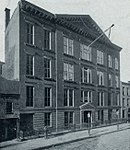14th Street station (IRT Sixth Avenue Line)

14th Street was a station on the demolished IRT Sixth Avenue Line in Manhattan, New York City. It had two tracks and two side platforms, and was served by trains from the IRT Sixth Avenue Line. The station opened on June 5, 1878, and was designed by famed Hudson River School painter Jasper Francis Cropsey, a trained architect. Beginning in 1907, the station had a connection to the 14th Street subway station of the Hudson and Manhattan Railroad. It closed on December 4, 1938. The next southbound stop was Eighth Street. The next northbound stop was 18th Street. Two years later the station was replaced by the IND Sixth Avenue Line platforms of the 14th Street / Sixth Avenue Subway station complex.
Excerpt from the Wikipedia article 14th Street station (IRT Sixth Avenue Line) (License: CC BY-SA 3.0, Authors, Images).14th Street station (IRT Sixth Avenue Line)
14th Street (PATH) underground passage, New York Manhattan
Geographical coordinates (GPS) Address Nearby Places Show on map
Geographical coordinates (GPS)
| Latitude | Longitude |
|---|---|
| N 40.737372 ° | E -73.996911 ° |
Address
6th Avenue
14th Street (PATH) underground passage
10011 New York, Manhattan
New York, United States
Open on Google Maps








